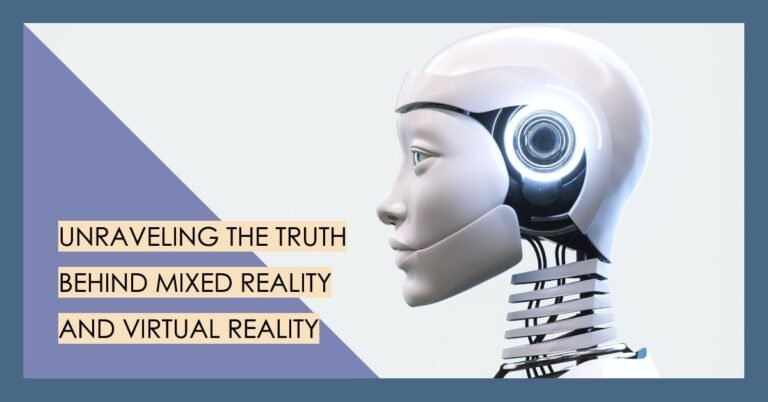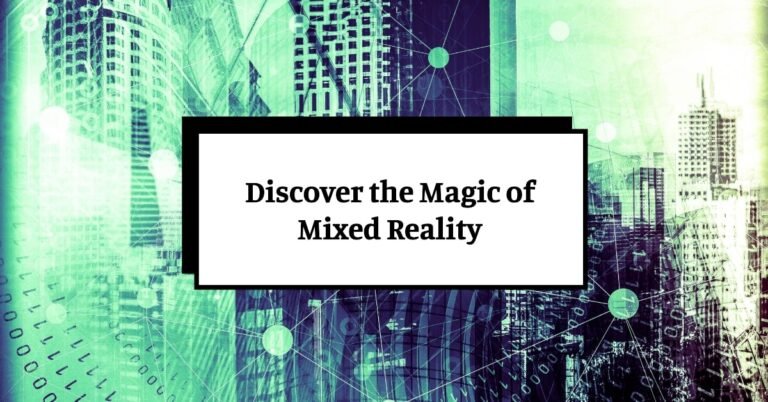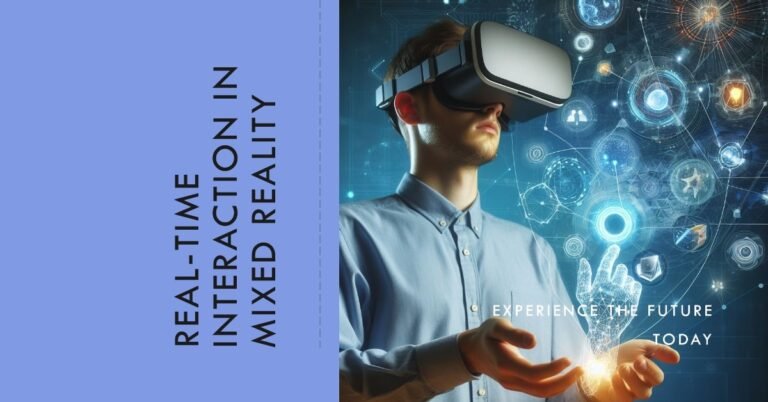Work From Anywhere! How Mixed Reality is Revolutionizing Remote Work
Picture this: you’re lounging on a beach in Bali, but instead of sipping cocktails and soaking up the sun, you’re immersed in a virtual conference room with colleagues scattered across the globe. You’re not just staring at faces on a screen – you’re all collaborating on a 3D model in real time, manipulating it with hand gestures, and discussing ideas with an enthusiasm usually reserved for in-person meetings.
This isn’t a scene from a futuristic movie – it’s the exciting reality of Work From Anywhere (WFH) powered by Mixed Reality (MR).
What exactly is Work From Anywhere with Mixed Reality?
Think beyond video calls and clunky screen-sharing sessions. WFH with MR takes remote work to a whole new level. Here’s the magic: MR blends the physical world with virtual elements, creating an immersive workspace that transcends physical limitations. Imagine collaborating with colleagues across the globe in a virtual conference room, complete with 3D whiteboards and interactive presentations. Or picture yourself attending a product launch event without leaving your living room, getting a first-hand look at the latest gadgets in stunning detail. This isn’t science fiction – it’s the future of remote work, and it’s happening right now.
We, at ARVRRealm.com, are passionate about the potential of Mixed Reality to revolutionize the way we work remotely. Throughout this article, we’ll be your guide. We’ll explore the benefits of MR for remote teams, showcase real-life examples of companies already embracing this technology, and answer all your burning questions. By the end, you’ll be equipped with the knowledge and resources to leverage this powerful tool and truly work from anywhere!
Benefits of MR for Remote Teams: How MR Empowers Remote Teams
The advantages of implementing Mixed Reality in remote work environments go far beyond simply feeling like you’re “present” in a virtual meeting. Here’s a deeper dive into how MR can truly transform your remote work experience:
- Enhanced Collaboration: Forget static presentations and endless email threads. MR allows for a more natural and interactive way to share ideas and work together. Imagine brainstorming sessions where colleagues from different locations can manipulate 3D models in real-time, virtually sketching out concepts and refining designs collaboratively. This fosters a more dynamic exchange of ideas, leading to better problem-solving and innovation.
- Improved Training and Onboarding: Onboarding new team members remotely can be challenging. MR bridges this gap by creating immersive training environments. New hires can be virtually transported to a realistic simulation, receiving hands-on guidance on complex procedures or equipment operation. This not only eliminates the need for expensive travel and in-person training but also creates a more engaging and effective learning experience that accelerates knowledge transfer and improves employee retention.
- Boosted Productivity: MR applications can streamline workflows by overlaying relevant information directly onto a user’s physical workspace. Imagine having real-time data visualizations or step-by-step instructions hovering right in front of you – no more flipping through manuals or searching for files on your computer. This reduces cognitive load, minimizes errors, and ultimately boosts overall productivity for your remote team.
- Reduced Isolation: Remote work can sometimes feel isolating, leading to decreased morale and motivation. However, MR fosters a sense of connection by creating virtual workspaces where colleagues can interact and socialize in a more natural setting. Imagine a virtual coffee break room where remote team members can unwind and have casual conversations – an essential element for building team spirit and fostering a positive remote work culture.
MR in Action – From Architecture to Manufacturing
These aren’t just theoretical possibilities. Companies across various industries are already utilizing MR to transform their remote work experiences and achieve remarkable results:
- Architecture Firms: Gone are the days of bulky physical models and lengthy travel for client meetings. Architectural firms are using MR headsets to collaboratively design buildings in a virtual space. Architects can visualize and refine 3D models in real-time with colleagues across different locations, allowing for a more streamlined design process and increased client satisfaction.
- Manufacturing Companies: Imagine a scenario where a technician on the factory floor encounters a complex equipment malfunction. Traditionally, they might have to wait for an experienced engineer to travel to the site for troubleshooting. However, with MR applications, technicians can receive remote assistance from experts who can virtually project instructions and highlight specific components needing repair directly onto the actual equipment. This not only reduces downtime but also allows for faster resolution of issues and improved efficiency.
- Marketing Agencies: Marketing teams are no longer limited by geographical constraints when it comes to client collaboration. MR tools enable them to work together on virtual presentations and campaigns, creating interactive content and sharing immersive product demos with clients remotely. This fosters a more engaging and impactful client experience, leading to better marketing outcomes.
- Healthcare: The potential applications of MR in healthcare are vast and transformative. Imagine surgeons virtually rehearsing complex procedures on 3D models of a patient’s anatomy before entering the operating room. This not only improves surgical accuracy but also reduces risks and optimizes patient outcomes. Additionally, MR can be used for remote patient consultations, allowing medical professionals to virtually examine patients and provide real-time guidance, regardless of location.
- Education and Training: The traditional classroom setting is no longer the only option for learning. MR can create immersive educational experiences that engage students and enhance knowledge retention. Imagine exploring historical landmarks in virtual reality or dissecting a virtual frog in a biology class – MR brings abstract concepts to life and fosters a deeper understanding of the subject matter. Furthermore, MR can be used for remote professional development, allowing individuals to participate in training workshops and conferences irrespective of their physical location.
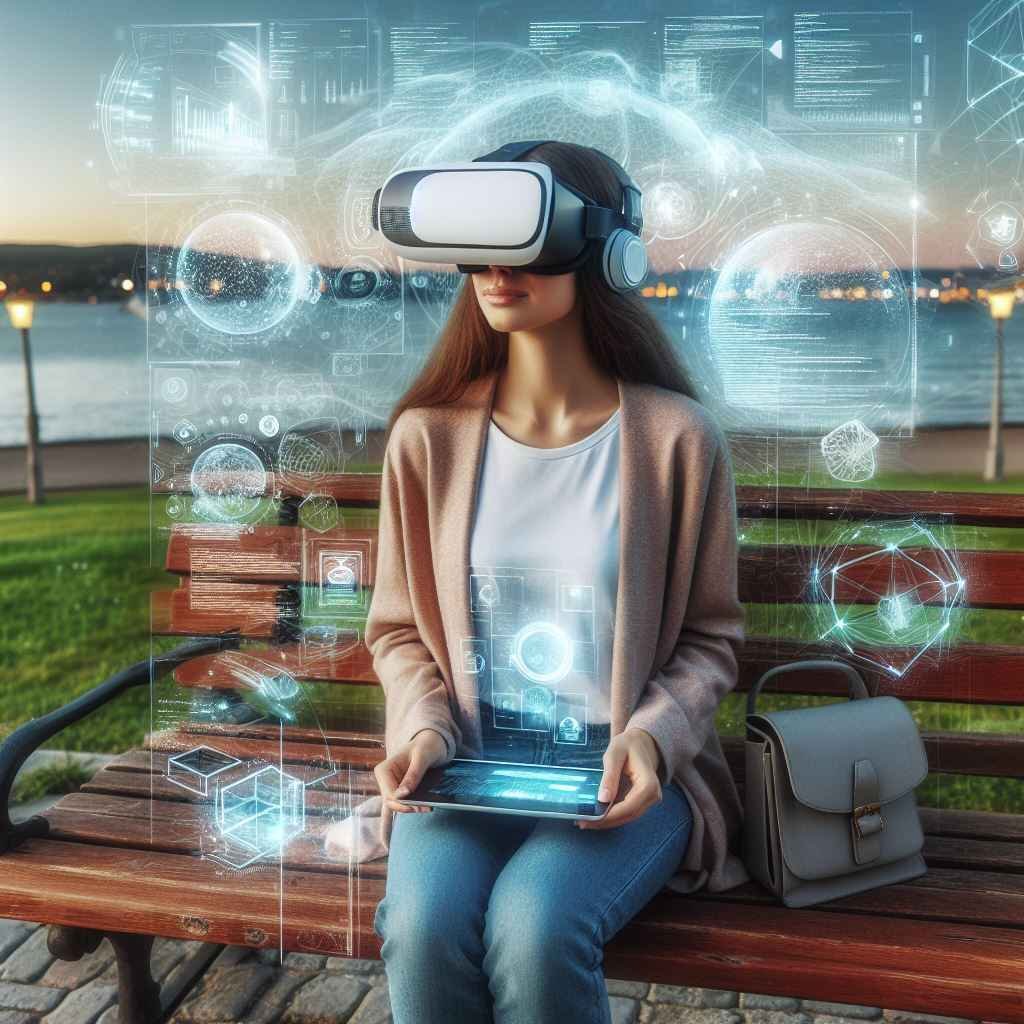
Getting Started with Work From Anywhere with MR: Your Guide to the Future of Work
Excited to explore the possibilities of Work From Anywhere with MR? Here’s a roadmap to help you navigate the initial steps:
- Research Available Tools: The MR landscape is constantly evolving, offering a diverse range of headsets and software solutions catering to different needs and budgets. Conduct thorough research to identify the right fit for your specific industry and team requirements. Consider factors like functionality, compatibility with existing hardware, user comfort, and cost when making your selection. Resources like ARVRRealm.com can be a valuable starting point for exploring different MR solutions and comparing features.
- Invest in Training: Don’t underestimate the importance of training your team on using MR technology effectively. This will ensure a smooth adoption process and maximize the benefits of MR for your remote work environment. Training programs should not only focus on the technical aspects of using the hardware and software but also delve into best practices for collaboration, communication, and workflow optimization within an MR environment.
- Start Small and Scale Up: Implementing a new technology can be overwhelming. To ease the transition, consider a phased approach. Begin by integrating MR for specific tasks or projects that can greatly benefit from its capabilities, such as brainstorming sessions, product design reviews, or remote training sessions. As your team gains comfort and expertise in using MR, you can gradually integrate it into more aspects of your remote work environment, fostering a seamless and productive workflow.
- Embrace a Culture of Innovation: Successfully leveraging MR requires a willingness to experiment and adapt. Encourage your team to explore new possibilities and identify innovative ways to utilize MR within your specific workflows. This fosters a culture of continuous improvement and ensures you’re maximizing the potential of this transformative technology.
Available Tools for Work From Anywhere with MR
Here are some tools that can facilitate remote work using mixed reality (MR):
- Microsoft HoloLens 2: This is a leading MR headset that allows for immersive collaboration and remote assistance. It’s used in conjunction with apps like Dynamics 365 Remote Assist and Microsoft Teams for training and problem-solving in real-time.
- Dynamics 365 Guides: This tool enables the creation of holographic workflows to train workers on machinery and procedures, overlaying instructions directly onto the physical environment.
- Azure Mixed Reality Services: Azure provides services that allow developers to create applications with spatial awareness, such as 3D training and design review, enhancing the remote work experience.
- MeetinVR: This VR collaboration tool brings team members into creative spaces for brainstorming and idea sharing, enhancing the remote collaboration experience.
These tools are transforming the way we work by enabling more interactive, collaborative, and efficient remote work environments.
Challenges and Considerations of Work From Anywhere with MR
While Mixed Reality (MR) offers exciting possibilities for Work From Anywhere, it’s important to acknowledge the challenges and considerations that come with implementing this technology. Here’s a breakdown of some key factors to keep in mind:
Technical Challenges:
- Cost: High-end MR headsets can be expensive, and the cost of software licenses can add up quickly, especially for larger teams. Finding the right balance between affordability and functionality is crucial.
- Limited Processing Power: Current MR technology requires powerful computers to function optimally. This can be a barrier for some businesses or remote workers with older computers.
- Connectivity: A stable and high-speed internet connection is essential for a smooth MR experience. Lag or glitches can disrupt workflows and hinder collaboration.
- Interoperability: Compatibility between different MR headsets and software solutions can be an issue. Businesses need to ensure their chosen MR ecosystem integrates seamlessly with existing hardware and software.
User Experience Considerations:
- Comfort: MR headsets can be bulky and heavy, leading to discomfort during extended use. User comfort is essential for maximizing productivity and minimizing fatigue.
- Learning Curve: There’s a learning curve associated with using MR technology effectively. Investment in training programs is necessary to ensure team members can navigate the software and hardware with ease.
- Accessibility: Not everyone has access to MR headsets, potentially creating an uneven playing field within remote teams. Businesses need to consider strategies for inclusive participation when implementing MR solutions.
- Safety Concerns: As with any technology, safety considerations are important. MR headsets can block users’ peripheral vision, potentially leading to accidents in physical surroundings. Establishing clear safety guidelines for using MR equipment in different environments is crucial.
Security and Privacy Concerns:
- Data Security: Working remotely with sensitive data in an MR environment necessitates robust security measures. Businesses need to choose MR solutions with strong encryption and authentication protocols to safeguard sensitive information.
- Privacy Concerns: MR technology raises privacy concerns, especially with the potential for eye-tracking and spatial mapping features. Businesses need to have clear policies regarding data collection and usage within the MR environment to ensure user privacy is protected.
Strategies to Overcome Challenges and Considerations
Despite these challenges, there are strategies to mitigate their impact and ensure a successful transition to Work From Anywhere with MR:
- Conduct thorough research: Carefully evaluate different MR hardware and software solutions to find the best fit for your budget and specific needs.
- Invest in training: Provide comprehensive training for your team on using MR technology effectively and safely.
- Start small and scale up: Begin by integrating MR for specific tasks or projects and gradually expand its use as your team gains experience.
- Prioritize user comfort: Choose ergonomic MR headsets and establish breaks during extended work sessions to minimize user fatigue or discomfort.
- Foster a culture of communication: Encourage open communication within your team to address any challenges or concerns regarding MR use.
- Stay informed about regulations: Keep track of any developing regulations around MR use in remote work environments.
- Monitor user health: Encourage employees to take breaks and be mindful of any potential health effects associated with extended MR use.
By acknowledging these challenges and considerations, and by implementing proactive strategies to address them, businesses can unlock the full potential of Work From Anywhere with MR and create a truly thriving remote work environment.
The Future of Work From Anywhere: A Glimpse into Remote Work with MR
Mixed Reality (MR) is revolutionizing the way we work remotely, and its impact is only set to grow in the coming years. Here’s a glimpse into what the future of remote work with MR might hold:
Evolution of MR Technology:
- More affordable and accessible hardware: Expect lighter, more comfortable, and more affordable MR headsets, making the technology accessible to a broader range of businesses and individuals.
- Advanced software functionalities: MR software will become more sophisticated, offering a wider range of applications specifically designed for remote work tasks, from project management to collaborative design and training simulations.
- Improved integration with existing tools: Seamless integration with popular collaboration platforms and productivity tools will streamline workflows and enhance user experience.
Enhanced Remote Collaboration:
- Hyper-realistic virtual workspaces: Imagine virtual conference rooms that feel indistinguishable from physical ones, complete with spatial audio and the ability to interact with virtual objects in real-time. This fosters a more natural and engaging collaborative experience for remote teams.
- Global talent pool access: MR will break down geographical barriers even further, allowing companies to tap into a global talent pool and build diverse and highly skilled remote teams.
- Improved communication and problem-solving: Immersive MR environments will facilitate more effective communication and problem-solving through real-time visualization and manipulation of data and concepts.
Revolutionized Training and Onboarding:
- Highly interactive learning experiences: Imagine new hires receiving hands-on training in a virtual environment that mimics real-world scenarios. This personalized and interactive approach will accelerate learning, improve knowledge retention, and reduce onboarding time.
- Reduced travel costs: MR-based training eliminates the need for expensive travel and in-person training sessions, making training more accessible and cost-effective for businesses.
- Upskilling and reskilling opportunities: MR will facilitate the creation of immersive learning experiences for upskilling and reskilling employees, allowing them to adapt to new technologies and stay competitive in the evolving job market.
The Evolving Role of the Physical Office:
- Shift towards collaborative hubs: Physical offices may transform into collaborative hubs focusing on fostering team spirit, brainstorming sessions, and social interaction.
- The rise of hybrid work models: Many businesses will likely adopt a hybrid work model, leveraging MR technology for remote work tasks while utilizing physical offices for specific activities requiring face-to-face interaction.
Challenges and Considerations:
While the future of remote work with MR is promising, there are still challenges to address, such as ensuring equitable access to technology, addressing potential security concerns, and establishing best practices for health and well-being in an MR work environment.
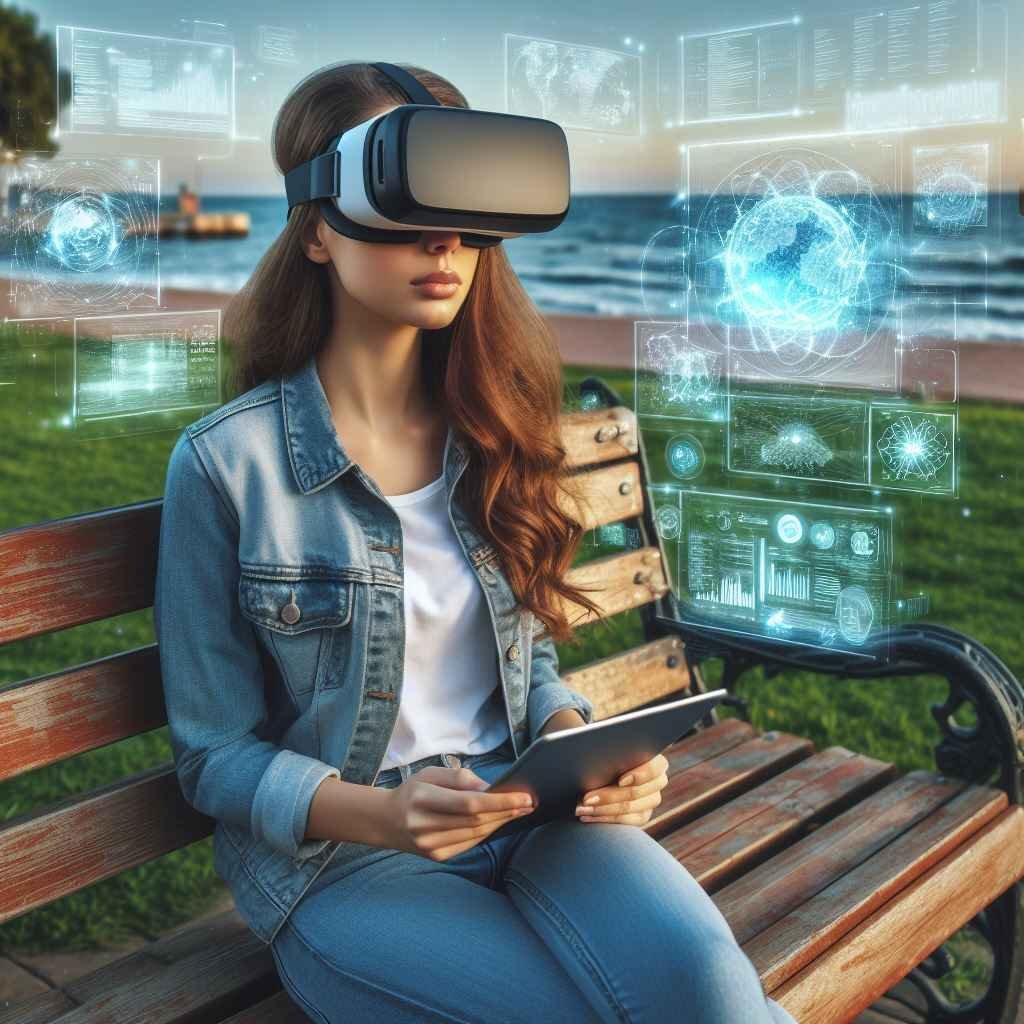
FAQs: Your Questions Answered About Work From Anywhere with MR
Is MR expensive?
The cost of MR technology varies depending on the specific hardware and software chosen. While high-end headsets can be expensive, more affordable options are becoming increasingly available. Additionally, the potential return on investment (ROI) in terms of improved collaboration, productivity, and reduced costs associated with travel and training can significantly outweigh the initial investment.
Is MR secure for business use?
As with any technology, security considerations are paramount when working remotely with sensitive data. However, many MR solutions offer robust security features like data encryption and multi-factor authentication. Choosing a solution with a strong focus on data security and implementing best practices like strong password management are crucial to ensure the safe and secure use of MR in your remote work environment.
Does everyone need an MR headset to work remotely with MR?
Not necessarily. While MR headsets offer the most immersive experience, some MR solutions offer functionalities accessible through laptops or tablets. This allows for a more gradual integration of MR technology, enabling team members without headsets to still participate in collaborative sessions and benefit from certain aspects of MR, such as viewing 3D models or accessing interactive presentations.
Conclusion: The Future of Work is Here – Embrace Work From Anywhere with MR
The future of work is no longer confined to the traditional office setting. Mixed Reality is paving the way for a truly globalized and collaborative work environment, empowering teams to work effectively from anywhere in the world. By leveraging the immersive and interactive capabilities of MR, businesses can unlock a new era of productivity, innovation, and employee satisfaction. Are you ready to embrace Work From Anywhere with MR? Take the first step today and explore the vast potential this revolutionary technology holds for transforming your remote work experience.



